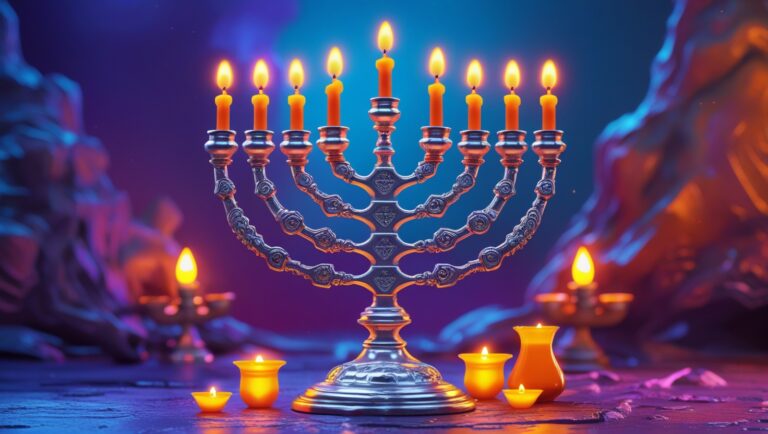Chana is one of the most respected women in Jewish history. Her bold prayer was not only accepted by Hashem, but she also became the mother of Shmuel the prophet. We read about Chana’s conversation with Eli the Kohen Gadol during the Haftarah on the second day of Rosh Hashanah because that’s when she received her answer.
A less frequently discussed part of her story is the vow she made to dedicate her future son, Shmuel, to the Mishkan (tabernacle) service. Vows are serious commitments that should never be taken lightly. R’ Chaim Vital writes in Sha’arei Kedusha that one should be extremely careful about making vows (or even hinting at them) unless they are certain they can keep them.
Ideally one should never do them because even if he has all the reasons to do it, he might be considered unworthy of swearing on Hashem’s name and may be punished. Of course, when one is facing danger of life (chas v’shalom), then the right thing to do would be to vow to do something if he’s saved.
Yet, Chana was not criticized for making her vow or for her daring declaration that she would seclude herself with another man to undergo the Sotah procedure and be blessed with a child. That was something only a huge Tzadika could do.
So, what can we learn from this from a Kabbalistic perspective?
The Nature of Vows
The Holy Zohar teaches that vows come from the Sephirah of Binah, the supernal “Mother” or “Understanding” that goes beyond physical laws. According to the Arizal in Sha’ar HaKavanot (Gate of Mystical Intentions), on Yom Kippur, the entire world is sustained by this Sephirah as everything is elevated.
We refrain from food, drink, leather shoes, anointing, and marital relations not because they are inherently wrong, but because in our elevated spiritual state, these things don’t exist as we know them. Instead, the world is nourished by the exalted spiritual “vapors” (“Havalim” in Hebrew) from the Sephirah of Binah. When we make a vow, we draw down these incredibly holy vapors from our mouths. This explains many laws about vows, including how they are pronounced and how they can be revoked.
We also bless people with our words. Rabbi Shmuel Vital, in his commentary on his father Rabbi Chaim Vital’s Sha’ar HaGilgulim (Gate of Reincarnation), explains that Eli the Kohen Gadol had such power in blessing Chana because he was the reincarnation of Yael (the righteous woman who killed Sisera). We see this because Eli’s name (עלי) and Yael’s name (יעל) use the same letters. When Dvorah the Prophetess blessed Yael in her song, she also blessed her reincarnations with incredible power.
The Kabbalah of Vows
Although the Zohar (II:91b) states that oaths occur in Nukva of Zeir Anpin and vows in the supernal Imma, or Binah, in essence, both actually take place in Nukva of Zeir Anpin. This is hinted at in the verse, “…her husband will confirm it and her husband will annul it” (Num. 30:14)—whether “it” refers to a vow or an oath.
“Her husband” here symbolizes Zeir Anpin, indicating that the subject is Nukva of Zeir Anpin. As we’ve discussed, the feminine aspect of our psyche drives us to realize G‑d’s purpose in creation, turning reality into His dwelling place. However, this drive must be balanced with the male drive to transcend the mundane reality and seek the abstract realm of spirituality. This balance is crucial because, without it, the drive to sanctify the material world can lead us too deeply into materialism, risking a loss of divine consciousness.
As the Sages teach, “vows ensure asceticism” (Avot 3:13), suggesting that we must set boundaries for ourselves as we engage with the material world to fulfill G‑d’s purposes. The Arizal elucidates how vows and oaths have a positive impact on Nukva, the feminine archetype.
The technical difference between a vow (Neder) and an oath (Shvuah) is that a vow is a commitment regarding a specific object, while an oath pertains to one’s own behavior.
The Mystical Meaning of Vows and Oaths
Vapor issues from the mouth of Zeir Anpin and transforms into light that envelops the seven lower sub-sefirot of his Nukva. These are the seven “vanities” mentioned at the beginning of Ecclesiastes.
The Hebrew word for “vapor,” “hevel,” also translates to “vanity,” implying something insubstantial. Ecclesiastes opens with: “‘Vanity of vanities,’ says Kohelet, ‘vanity of vanities, all is vanity.'” The word “vanity” appears three times in the singular and twice in the plural. If we consider each plural to represent two, we get a total of seven vanities.
In this context, “vapor” is understood in its primary sense.
These vapors emanate from the mouth of Zeir Anpin. This is the mystical essence of a true oath. It is a positive commandment to make a truthful oath in G‑d’s name when required by the Torah, as stated, “…and you will swear by His Name” (Deut. 10:20).
The process of making a vow or an oath is deeply rooted in this spiritual framework. The act of uttering a vow draws down these holy vapors, transforming them into a spiritual light that influences the lower aspects of the feminine archetype. This connection highlights the power and significance of our words and their ability to impact both the spiritual and material realms. By understanding this mystical process, we can appreciate the depth and responsibility that comes with making vows and oaths.
The Hebrew word for “oath,” “shavua,” (שבועה) is related to the word for “seven,” “sheva,” and can be understood as a passive form, implying “to seventh oneself.” Mystically, this means enveloping the seven lower sefirot of Nukva (Malkhut) with the vapor from the mouth of Zeir Anpin.
The seven vapors of light that envelop Nukva originate from the mouth of Zeir Anpin, which is associated with “truth.” Thus, when someone makes a true oath, they draw forth light-vapor from Zeir Anpin’s mouth. This manifests as seven vapors that surround the seven lower sub-sefirot of Nukva, enveloping her as a light envelops her body. Her stature extends from the chest of Zeir Anpin downward, as is known.
As a result, the light from his mouth can fully envelop her as it descends. In her immature state, Nukva is only as “tall” as the midot (attributes) of Zeir Anpin and reflects his emotional state. This is what Rabbi Chaim Vital also teaches in Shaar HaGilgulim that a woman acquires all the levels of her husband automatically.
Thus, “oaths” occur in Nukva of Zeir Anpin but are given to her by her husband, Zeir Anpin. This is why Scripture states, “her husband will confirm it and her husband will annul it.”
A “true oath” is so termed because it represents an enveloping light (Ohr Makkif). All enveloping lights derive from the name Eh-yeh, and the numerical value of EHYH squared equals the numerical value of the word for “truth” (“emet”).
אהיה” (EHYH) has the Gematria = 1 + 5 + 10 + 5 = 21.
212 = 441.
“Emet” (אמת) “Truth” has the Gematria = 1 + 40 + 400 = 441.
Moreover, the Zohar (Tikunei Zohar 74b) discusses the verse “And now, let the power of my L-rd be magnified” (Bamidbar. 14:17), explaining that Malkhut is referred to as “the power of my L-rd” (Adonai, meaning “my Lord”). This is because Malkhut is also known as “Beth Sheba” or “Bat Sheva” (“the daughter of seven”).
Each of her seven lower sub-sefirot manifests a name Havayah, and there are seven such Names Havayah, totaling 28 letters. Collectively, these are termed “the power of Havayah,” which is why malchut is called “Batsheva.”
So an oath is drawing down all these powers from Zeir Anpin to Malkhut, and can indeed effect miracles and salvations for even desperate situations.
The Exaltedness of Rosh Hashanah
As we prepare for Rosh Hashanah, understanding its significance from a Kabbalistic perspective is crucial. According to the Rasha’sh (Rabbi Shalom Sharabi), on the first day of Rosh Hashanah, we focus on our spiritual (internal) needs, while on the second day, we pray for our physical (external) needs. This is reflected in the mystical intentions (Kavanot) found in his Siddur Nahar Shalom.
We will explore this more in a separate post, but the main goal of Rosh Hashanah is to crown Hashem as King over the entire world and over each part of our souls. The sound of the Shofar, which originates from the exalted vapors from the Sephirah of Binah, has immense power to bring us to Teshuva (repentance), which also stems from the Sephirah of Binah. The Shofar has the same source as the oaths.
Chana received her answer on the second day of Rosh Hashanah when she prayed for a son who would illuminate the Jewish people, even though this day is traditionally focused on physical needs. When you hear the Shofar blast, it’s an opportune moment (e’t ratzon) to ask for anything you need. We should make the most of this opportunity.
Chana, the righteous prophetess, teaches us to be bold in asking for our needs. Though she went so far as to almost “threaten” Hashem, this shouldn’t be attempted by just anyone. As mentioned in our article about Shmuel, her son, she did it with deep wisdom and for very specific Kabbalistic reasons related to her soul root.
Her burial place is not known, and the one in Tzfat for “Chana and her seven sons” is another important Tzadika, though not the same Chana, mother of Shmuel.
May her memory be a blessing and inspiration!







